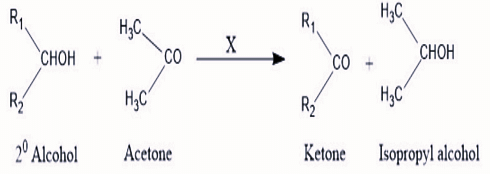Question:
Write short notes on the following:
(i) Aldol condensation
(ii) Decarboxylation
(iii) Cannizzaro reaction
Write short notes on the following:
(i) Aldol condensation
(ii) Decarboxylation
(iii) Cannizzaro reaction
(i) Aldol condensation
(ii) Decarboxylation
(iii) Cannizzaro reaction
Show Hint
Aldol = $\alpha$-H present, Cannizzaro = $\alpha$-H absent, Decarboxylation = loss of $CO_2$.
Updated On: Oct 7, 2025
Hide Solution
Verified By Collegedunia
Solution and Explanation
(i) Aldol Condensation:
Aldol condensation is a reaction in which aldehydes or ketones having $\alpha$-hydrogen atoms undergo self-condensation in the presence of a dilute base (NaOH, KOH) to form $\beta$-hydroxy aldehydes (aldols) or $\beta$-hydroxy ketones. On heating, these dehydrate to form $\alpha,\beta$-unsaturated aldehydes or ketones.
\[ 2CH_3CHO \; \xrightarrow{NaOH} \; CH_3CH(OH)CH_2CHO \; \xrightarrow{\Delta} \; CH_3CH=CHCHO \] (ii) Decarboxylation:
Decarboxylation is the elimination of a carboxyl group ($-COOH$) from carboxylic acids as carbon dioxide. This generally takes place in the presence of soda lime (NaOH + CaO).
\[ C_6H_5COOH + NaOH \; \xrightarrow{CaO, \; \Delta} \; C_6H_6 + Na_2CO_3 \] This reaction is useful for decreasing the carbon chain length by one carbon atom. (iii) Cannizzaro Reaction:
Aldehydes which do not have $\alpha$-hydrogen undergo self-oxidation and reduction (disproportionation) in the presence of concentrated alkali to form a primary alcohol and a carboxylate salt.
\[ 2HCHO \; \xrightarrow{Conc. NaOH} \; CH_3OH + HCOONa \] Example: Formaldehyde gives methanol and sodium formate. Conclusion:
Aldol condensation forms C–C bonds, decarboxylation removes $-COOH$ groups, and Cannizzaro reaction gives alcohols and salts from aldehydes without $\alpha$-hydrogen.
Aldol condensation is a reaction in which aldehydes or ketones having $\alpha$-hydrogen atoms undergo self-condensation in the presence of a dilute base (NaOH, KOH) to form $\beta$-hydroxy aldehydes (aldols) or $\beta$-hydroxy ketones. On heating, these dehydrate to form $\alpha,\beta$-unsaturated aldehydes or ketones.
\[ 2CH_3CHO \; \xrightarrow{NaOH} \; CH_3CH(OH)CH_2CHO \; \xrightarrow{\Delta} \; CH_3CH=CHCHO \] (ii) Decarboxylation:
Decarboxylation is the elimination of a carboxyl group ($-COOH$) from carboxylic acids as carbon dioxide. This generally takes place in the presence of soda lime (NaOH + CaO).
\[ C_6H_5COOH + NaOH \; \xrightarrow{CaO, \; \Delta} \; C_6H_6 + Na_2CO_3 \] This reaction is useful for decreasing the carbon chain length by one carbon atom. (iii) Cannizzaro Reaction:
Aldehydes which do not have $\alpha$-hydrogen undergo self-oxidation and reduction (disproportionation) in the presence of concentrated alkali to form a primary alcohol and a carboxylate salt.
\[ 2HCHO \; \xrightarrow{Conc. NaOH} \; CH_3OH + HCOONa \] Example: Formaldehyde gives methanol and sodium formate. Conclusion:
Aldol condensation forms C–C bonds, decarboxylation removes $-COOH$ groups, and Cannizzaro reaction gives alcohols and salts from aldehydes without $\alpha$-hydrogen.
Was this answer helpful?
0
0
Top Questions on carbonyl compounds
- Which of the following are neutral?
- KEAM - 2025
- Chemistry
- carbonyl compounds
- Acetone can be converted to 2-methylpropan-2-ol using:
- KEAM - 2025
- Chemistry
- carbonyl compounds
- The correct stability order of carbocations is
- JEE Main - 2024
- Chemistry
- carbonyl compounds
- According to Oppenauer Oxidation reaction, oxidation of secondary alcohol to ketone by reagent (X) in acetone takes place, what is "X" :

- GPAT - 2024
- Organic Chemistry
- carbonyl compounds
- The Gattermann-Koch reaction is used in the industrial preparation of benzaldehyde. The electrophile involved in this reaction is
- CUET (UG) - 2024
- Chemistry
- carbonyl compounds
View More Questions
Questions Asked in UP Board XII exam
- Change any one of the following into indirect narration:
(i) The General said to his soldiers, "March forward and kill the enemy."- UP Board XII - 2025
- Direct And Indirect Speech
- What do you understand by order of a reaction? Calculate the total order of those reactions which have velocity equations:
(i) Velocity \( = K[A]^{1/2}[B]^{3/2} \)
(ii) Velocity \( = K[A]^3[B]^{-1} \)- UP Board XII - 2025
- Order of reaction
- Find the maximum kinetic energy of the photo-electrons ejected, when light of wavelength 3300 Å is incident on a Cesium surface. Work function of Cesium = 1.9 eV.
- UP Board XII - 2025
- Photoelectric Effect
- Prove that the semi-vertical angle of a cone with given slant height and maximum volume is \( \tan^{-1}(\sqrt{2}) \).
- UP Board XII - 2025
- Mathematics
- What are different means of production and the rewards given to them?
- UP Board XII - 2025
- Economics
View More Questions